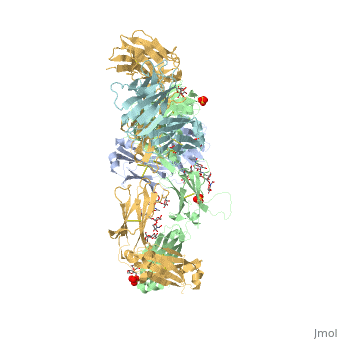Keytruda
From Proteopedia
(Difference between revisions)
m (Melanie Kusakavtich was also a major contributor to this project.) |
|||
| (One intermediate revision not shown.) | |||
| Line 1: | Line 1: | ||
==Pembrolizumab antibody against programmed cell death-1 receptor== | ==Pembrolizumab antibody against programmed cell death-1 receptor== | ||
| - | <StructureSection load='5dk3' size='350' side='right' caption='Full-Length Crystal Structure of Pembrolizumab (PDB code [[5dk3]])'> | + | <StructureSection load='5dk3' size='350' side='right' caption='Full-Length Crystal Structure of glycosylated Pembrolizumab complex with sulfate (PDB code [[5dk3]])'> |
== Structure and Function == | == Structure and Function == | ||
| - | Pembrolizumab, trade name Keytruda, is an immunoglobulin G4 (IgG4)-kappa humanized monoclonal antibody against the programmed cell death-1 (PD-1) receptor. It contains an Fv fragment (PemFv) that is the variable region of the molecule where binding occurs, as well as a Fab fragment (PemFab) that constitutes the entire molecule. Pembrolizumab is a very compact molecule with an asymmetrical Y-shape. The short compact hinge region inflicts constraints on the molecule that creates the abnormal crystallizable heavy chain/tail region (Fc domain) compared to other immunoglobulin G (IgG) proteins. The heavy chain is <scene name='74/745945/Glycosylation/1'>glycosylated at Asp297</scene> at both CH<sub>2</sub> domains on each chain and one of them is distinctively rotated 120° compared to other similar structures, making the glycan chain more solvent accessible. IgG4s have a unique function where they form dynamic bispecific antibodies by exchanging half-molecules (one heavy chain/light chain pair) among themselves, called Fab-arm exchange. This makes the molecule particularly unstable and unpredictable as a treatment, but is conquered by introducing the serine-to-proline mutation at <scene name='74/745945/Pro228/1'>amino acid 228</scene>, which prevents Fab-arm exchange and stabilizes the molecule <ref name="log">DOI:10.1080/17425255.2016.1216976</ref>. | + | '''Pembrolizumab''', trade name '''Keytruda''', is an immunoglobulin G4 (IgG4)-kappa humanized monoclonal antibody against the programmed cell death-1 (PD-1) receptor. It contains an Fv fragment (PemFv) that is the variable region of the molecule where binding occurs, as well as a Fab fragment (PemFab) that constitutes the entire molecule. Pembrolizumab is a very compact molecule with an asymmetrical Y-shape. The short compact hinge region inflicts constraints on the molecule that creates the abnormal crystallizable heavy chain/tail region (Fc domain) compared to other immunoglobulin G (IgG) proteins. The heavy chain is <scene name='74/745945/Glycosylation/1'>glycosylated at Asp297</scene> at both CH<sub>2</sub> domains on each chain and one of them is distinctively rotated 120° compared to other similar structures, making the glycan chain more solvent accessible. IgG4s have a unique function where they form dynamic bispecific antibodies by exchanging half-molecules (one heavy chain/light chain pair) among themselves, called Fab-arm exchange. This makes the molecule particularly unstable and unpredictable as a treatment, but is conquered by introducing the serine-to-proline mutation at <scene name='74/745945/Pro228/1'>amino acid 228</scene>, which prevents Fab-arm exchange and stabilizes the molecule <ref name="log">DOI:10.1080/17425255.2016.1216976</ref>. |
== Mechanism == | == Mechanism == | ||
Current revision
Pembrolizumab antibody against programmed cell death-1 receptor
| |||||||||||
References
- ↑ 1.0 1.1 Longoria TC, Tewari KS. Evaluation of the pharmacokinetics and metabolism of pembrolizumab in the treatment of melanoma. Expert Opin Drug Metab Toxicol. 2016 Oct;12(10):1247-53. doi:, 10.1080/17425255.2016.1216976. Epub 2016 Aug 16. PMID:27485741 doi:http://dx.doi.org/10.1080/17425255.2016.1216976
- ↑ 2.0 2.1 2.2 2.3 Horita S, Nomura Y, Sato Y, Shimamura T, Iwata S, Nomura N. High-resolution crystal structure of the therapeutic antibody pembrolizumab bound to the human PD-1. Sci Rep. 2016 Oct 13;6:35297. doi: 10.1038/srep35297. PMID:27734966 doi:http://dx.doi.org/10.1038/srep35297
- ↑ Rajakulendran T, Adam DN. Spotlight on pembrolizumab in the treatment of advanced melanoma. Drug Des Devel Ther. 2015 Jun 4;9:2883-6. doi: 10.2147/DDDT.S78036. eCollection, 2015. PMID:26082618 doi:http://dx.doi.org/10.2147/DDDT.S78036
- ↑ Deeks ED. Pembrolizumab: A Review in Advanced Melanoma. Drugs. 2016 Mar;76(3):375-86. doi: 10.1007/s40265-016-0543-x. PMID:26846323 doi:http://dx.doi.org/10.1007/s40265-016-0543-x
Melanie Kusakavitch also contributed equally to this project, but the computer program is not showing her name due to malfunction.

